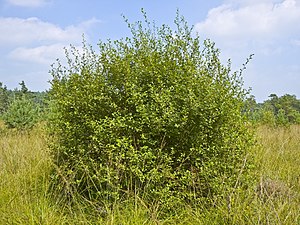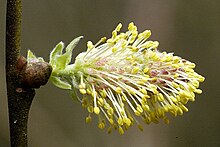Ear willow
| Ear willow | ||||||||||||
|---|---|---|---|---|---|---|---|---|---|---|---|---|

Ear willow ( Salix aurita ) |
||||||||||||
| Systematics | ||||||||||||
|
||||||||||||
| Scientific name | ||||||||||||
| Salix aurita | ||||||||||||
| L. |
The ear-pasture , Öhrchen willow or Sage Willow ( Salix aurita ) is a plant from the genus of pastures within the family of the pasture plants (Salicaceae).
description
Vegetative characteristics
The ear willow is a deciduous, multi-stemmed, richly branched shrub , rarely a small tree and reaches heights of 2 to 3 meters. The gray-brown bark of the twigs is initially tomentose and remains smooth, later changing its color from brown to blackish. The winter buds are brown to red, glabrous, egg-shaped and 3 to 5 mm long. The winter branches are missing a terminal bud.
The alternate leaves arranged on the branches are divided into a petiole and a leaf blade. The petiole is 4 to 10 millimeters long. The simple leaf blade is obovate with a length of up to 5 centimeters and a width of about 2.5 centimeters. The upper side of the leaf is dark green, the underside whitish to blue-green and hairy on both sides. The tip of the spade is usually twisted and the leaf margin is roughly serrated irregularly. The permanent stipules are kidney-shaped.
Generative characteristics
The flowering period extends from March to May. The ear willow is dioeciously separated sex ( diocesan ). The inconspicuous flowers appear in kitten-shaped inflorescences before the leaves shoot . The male kittens are up to 2.5 inches long and the female up to 3 inches long.
The many-seeded capsule fruit is 7 to 8 millimeters long. The fruit ripens in May and June.
The number of chromosomes is 2n = 38 or 76.
Occurrence
The natural range of the ear willow extends over Europe and western Asia . In Central Europe , the ear willow thrives from the lowlands at altitudes of up to 1800 meters in the northern Alps . In the Allgäu Alps, it rises in Bavaria on the Söllereck to an altitude of up to 1650 meters.
Salix aurita thrives best on moist, low- alkali and low-nutrient salt sand to sand loam soils . It is often to be found in flat moors , spring swamps and at the edges of ditches. The ear willow, which needs light, often grows outdoors , but is also associated with Sal willow ( Salix caprea ), downy birch ( Betula pubescens ), gray alder ( Alnus incana ), black alder ( Alnus glutinosa ) and buckthorn ( Frangula alnus ). It is a characteristic species of Salicetum auritae from the Association Salicion cinereae and also comes in plant communities of the sub-association Frangulo Rubenion ago.
literature
- Ulrich Hecker: BLV Handbook Trees and Shrubs. Munich 2006, ISBN 3-405-15876-1
Individual evidence
- ↑ a b Erich Oberdorfer : Plant-sociological excursion flora for Germany and neighboring areas. 8th edition. Verlag Eugen Ulmer, Stuttgart 2001, ISBN 3-8001-3131-5 , p. 308.
- ↑ Erhard Dörr, Wolfgang Lippert : Flora of the Allgäu and its surroundings. Volume 1, IHW, Eching 2001, ISBN 3-930167-50-6 , p. 413.
Web links
- Salix aurita L., ear willow. In: FloraWeb.de.
- Profile and distribution map for Bavaria . In: Botanical Information Hub of Bavaria .
- Ear willow . In: BiolFlor, the database of biological-ecological characteristics of the flora of Germany.
- Salix aurita L. In: Info Flora , the national data and information center for Swiss flora . Retrieved October 3, 2015.
- Determination aid at baumkunde.de .
- Distribution in the northern hemisphere according to: Eric Hultén , Magnus Fries: Atlas of North European vascular plants 1986, ISBN 3-87429-263-0 .
- Thomas Meyer: Data sheet with identification key and photos at Flora-de: Flora von Deutschland (old name of the website: Flowers in Swabia ).


